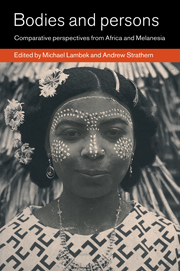Book contents
- Frontmatter
- Contents
- List of illustrations
- List of contributors
- Acknowledgments
- 1 Introduction: Embodying sociality: Africanist–Melanesianist comparisons
- Part I Transcending dichotomies
- Part II Transitions, containments, decontainments
- 6 Treating the affect by remodelling the body in a Yaka healing cult
- 7 To eat for another: taboo and the elicitation of bodily form among the Kamea of Papua New Guinea
- 8 Electric vampires: Haya rumors of the commodified body
- Part III From exchange to history
- Bibliography
- Index
7 - To eat for another: taboo and the elicitation of bodily form among the Kamea of Papua New Guinea
Published online by Cambridge University Press: 05 June 2012
- Frontmatter
- Contents
- List of illustrations
- List of contributors
- Acknowledgments
- 1 Introduction: Embodying sociality: Africanist–Melanesianist comparisons
- Part I Transcending dichotomies
- Part II Transitions, containments, decontainments
- 6 Treating the affect by remodelling the body in a Yaka healing cult
- 7 To eat for another: taboo and the elicitation of bodily form among the Kamea of Papua New Guinea
- 8 Electric vampires: Haya rumors of the commodified body
- Part III From exchange to history
- Bibliography
- Index
Summary
Meyer Fortes once wrote about the privileged place that food taboos occupy in the discipline of anthropology. Eating, he argued, is a uniquely individual act in that each person must eat for her or himself – it is not an activity that one person can undertake for another (also quoted in M. Strathern 1988:20). Furthermore, eating is both “organic” and “social”: “it is a means by which we are not merely made aware of an external reality but take permitted parts of it into our [body] …” (Fortes 1966:16). This being so, it is not surprising that food taboos have captured the imagination of anthropologists. Not unlike Lévi-Strauss's (1949) leitmotif – the incest prohibition – dietary restrictions tease and titillate us with the possibility of casting light on some of the West's most persistent analytical dilemmas: the relationship between mind and body, and the individual and society.
I am not in this chapter going to offer up a new theory of taboo. Nor will I enter into some of the more specific debates which have surrounded how anthropologists have approached the subject (see Lévi-Strauss 1962). Instead, I want to examine one feature of taboos which has received scant analytical attention: their capacity to image the apparently contradictory states of unity and disjuncture. Most anthropological treatments of taboo have taken the issue of boundary maintenance and disjuncture as their point of departure.
- Type
- Chapter
- Information
- Bodies and PersonsComparative Perspectives from Africa and Melanesia, pp. 158 - 171Publisher: Cambridge University PressPrint publication year: 1998
- 4
- Cited by



